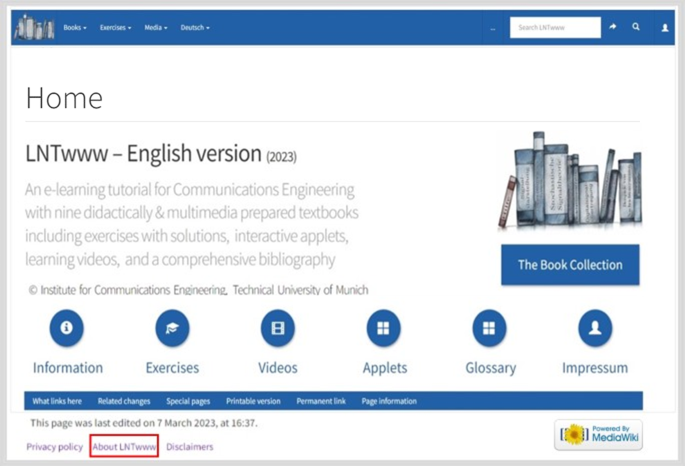Difference between revisions of "An e-learning project for Communications Engineering - LNTwww"
| Line 78: | Line 78: | ||
# Integrals often have to be solved beforehand, such as in [[Aufgaben:Exercise_4.4:_Two-dimensional_Gaussian_PDF|»Exercise 4.4: Two-dimensional Gaussian probabilty density function«.]] | # Integrals often have to be solved beforehand, such as in [[Aufgaben:Exercise_4.4:_Two-dimensional_Gaussian_PDF|»Exercise 4.4: Two-dimensional Gaussian probabilty density function«.]] | ||
| − | *We recommend: Print the exercise first ⇒ »printable version« and solve the exercise offline before checking online | + | *We recommend: Print the exercise first ⇒ »printable version« and solve the exercise offline before checking online. |
}} | }} | ||
Revision as of 17:13, 8 January 2024
$\text{Gerhard Kramer}$ and $\text{Günter Söder}$
The e-learning project »LNTwww« offered by the »TUM Institute for Communications Engineering« provides nine online courses on the subjects of »Communications Engineering« $\rm (CE)$ and »Information and Communication Technology« $\text{(I&C)}$. The target group of our online offer are students of these or similar disciplines as well as practicing engineers and scientists.
The German version »www.LNTwww.de« was created between 2001–2021. At the beginning of corona $($2020$)$ we started the English version, which has been finalized in 2023. In the following we refer to this version »en.lntwww.de«, whose homepage can be seen in the graphic below.
Here are some features of our e-learning platform:
- »LNTwww« is freely accessible $($no need for registration$)$. No specific system requirements.
- »LNTwww« uses the free server-based software »MediaWiki«, just like »Wikipedia«, the best-known free encyclopedia.
- The »Book Collection« link takes you to the nine courses $($which are referred to as »books«$)$ and to the collection »Biographies and Bibliographies«.
- The »Exercises« link takes you to a list with a total of around $640$ exercises and $3100$ subtasks $($each with a detailed sample solution$)$.
- About thirty learning videos $($in German language$)$ can get accessed via the »Videos« link. These are grouped according to the individual courses.
- Via the »Applets« link you have access to around thirty applets based on HTML5/JavaScript and some older shockwave flash $($SWF$)$ applets.
Other important project features are summarized in the file »About LNTwww« $($red marked link$)$, among others:
- »The didactic concept of LNTwww«: These rules from 2001 still apply, although »LNTwww« has had to be continuously adapted to developments on the Internet.
- »Content and scope of LNTwww«: Our online offer corresponds to conventional courses with a total of 36 semester hours per week of lectures and exercises.
LNTwww design and structure
»LNTwww« has a book structure. Each »course« corresponds to an own »book« that can be selected via »Book Collection«.
- Each book is divided into several »main chapters«,
- each main chapter is divided into several »chapters«, and
- each chapter comprises several »sections«.
$\text{Example A:}$ To illustrate these statements, here is an example of how to use »LNTwww«:
$(1)$ After pressing the »Book Collection« button, a selection screen appears with the nine textbooks as well as the book »Biographies and Bibliographies«.
$(2)$ After selecting »Information Theory«, its »start page« appears with links to four main chapters and links to exercises, multimedia elements and literature.
$(3)$ We now select the first main chapter »Entropy of Discrete Sources« and of this in turn the first subchapter »Discrete Memoryless Sources« with eight sections.
$(4)$ This exemplary subchapter explains the procedure for calculating the entropy of binary and non-binary sources.
$(5)$ As in conventional mathematical and technical literature, the facts are illustrated by texts, models, graphs, diagrams, equations and derivations.
$(6)$ The last two sections of each subchapter are exercises and references to the topic covered.
LNTwww exercises
A central role in our didactic concept play »exercises«. We believe that the sensible use of »LNTwww« by a user with previous knowledge should be that he first work on the exercises relating to his actual learning area and only jump to the corresponding theory section when required.
All exercises are structured in the same way:
- Each exercise consists of the »exercise description« and several »subtasks«. An exercise is only solved correctly if all subtasks are correct.
- For each exercise there is a detailed »sample solution«, sometimes with the indication of several ways to the goal.
- The »exercise types« used are:
- »Single Choice» ⇒ only one of the $n$ given answers is correct;
⇒ Marks of alternative answers: ${\huge\circ}$ - »Multiple Choice« ⇒ of the $n$ given answers, between zero and $n$ answers can be correct;
⇒ Marks of alternative answers: $\square$ - »Arithmetic Task« ⇒ numerical value query, possibly with sign;
small deviations $($usually $\pm 3\%)$ are allowed when checking real-valued results.
- We distinguish between »exercises« $($e.g. »Exercise 1.1»$)$ and »additional exercises« $($e.g. »Exercise 1.1Z«$)$.
- If you were able to solve all exercises of a chapter without any problems, we believe that you are familiar with the content of the entire chapter.
- If you have solved one exercise incorrectly, you should also work on the following, usually somewhat easier additional exercise.
$\text{Example B:}$ The $58$ exercises/additional exercises of the first book can be accessed via the link »Signal Representation: Exercises«.
- From there, we move on to the individual exercises, e.g. to »Exercise 1.1: Music Signals«. This relatively simple exercise consists of
- one »Single Choice« ⇒ subtask (1),
- two »Multiple Choice« ⇒ subtasks (2), (3), and
- one »Arithmetic Task« with two real-valued computational queries ⇒ subtask (4).
- However, most of our exercises are not that easy. Although MediaWiki also calls an arithmetic task »quiz«, answering them is usually much more difficult than in the numerous quiz shows on TV. Because:
- There are no predetermined answers in an arithmetic exercise, and moreover:
- Integrals often have to be solved beforehand, such as in »Exercise 4.4: Two-dimensional Gaussian probabilty density function«.
- We recommend: Print the exercise first ⇒ »printable version« and solve the exercise offline before checking online.
LNTwww applets
LNTwww learning videos
